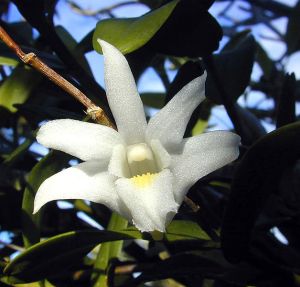No edit summary |
No edit summary Tag: wikieditor |
||
| Line 10: | Line 10: | ||
Commonly called the pigeon orchid, it is found in Chinese Himalayas, Taiwan, India, Sri Lanka, Andaman Islands, Myanmar, Thailand, Malaysia, Cambodia, Laos, Vietnam, Lesser Sunda Islands, Moluccas, Sulawesi, Sumatra, Papua New Guinea, Christmas Islands and the Philippines in semi-deciduous and deciduous dry lowland forests and savanna-like woodlands at an altitude of sea-level to 500m and grows small to large sized, warm to hot, best mounted on wood with spindle shaped, swollen basally for a few nodes, ridged, yellow with age stems that can branch, carrying, 4 to 19, thick, leathery, eventually deciduous leaves that will flower on the upper nodes of the leafless older canes with several to many fragrant flowers, albeit for only a few hours, after a temperature drop and rain. It has a tendency to keiki and when there are 2 small pseudobulbs and a third starting they can be broken away from the old pseudobulb and mounted to a small branch. This species is often found in conjunction with ants and may benefit from their presence. | Commonly called the pigeon orchid, it is found in Chinese Himalayas, Taiwan, India, Sri Lanka, Andaman Islands, Myanmar, Thailand, Malaysia, Cambodia, Laos, Vietnam, Lesser Sunda Islands, Moluccas, Sulawesi, Sumatra, Papua New Guinea, Christmas Islands and the Philippines in semi-deciduous and deciduous dry lowland forests and savanna-like woodlands at an altitude of sea-level to 500m and grows small to large sized, warm to hot, best mounted on wood with spindle shaped, swollen basally for a few nodes, ridged, yellow with age stems that can branch, carrying, 4 to 19, thick, leathery, eventually deciduous leaves that will flower on the upper nodes of the leafless older canes with several to many fragrant flowers, albeit for only a few hours, after a temperature drop and rain. It has a tendency to keiki and when there are 2 small pseudobulbs and a third starting they can be broken away from the old pseudobulb and mounted to a small branch. This species is often found in conjunction with ants and may benefit from their presence. | ||
Latest revision as of 16:21, 11 June 2024

Common Name: The Purse-Shaped Dendrobium, The Pigeon Orchid, The Bag-Shaped Dendrobium
Scented: yes
Light Requirements: partial sun
Temperature Requirements: intermediate to hot
Blooms: spring to summer
Flower Size: 5cm or less
Synonyms: *Angraecum crumenatum Rhump.; Aporum crumenatum (Sw.) Brieger 1981; Aporum ephemerum (J.J.Sm.) Rauschert 1983; Aporum kwashotense (Hayata) Rauschert 1983; Aporum papilioniferum (J.J.Sm.) Rauschert 1983; Aporum scalpelliforme (Teijsm. & Binn.) Rauschert 1983; Callista crumenatum [Sw.] O.Ktze. 1891; Ceraia ephemera (J.J.Sm.) M.A.Clem. 2003; Ceraia papilionifera (J.J.Sm.) M.A.Clem. 2003; Ceraia parviflora (Ames & C.Schweinf.) M.A.Clem. 2003; Ceraia simplicissima Lour. 1791; Dendrobium caninum Merr. 1921; Dendrobium ceraia Lindley 1830; Dendrobium coninum Sw. ?; Dendrobium crumenatum var. parviflora Ames & C.Schweinf. in ?; Dendrobium cumulatum Krzl not Lindley ?; Dendrobium ephemerum (J.J.Sm.) J.J.Sm. in E.D.Merrill 1917; Dendrobium kwashotense Hayata 1914; Dendrobium papilioniferum J.J.Sm. 1905; Dendrobium papilioniferum var. ephemerum J.J.Sm 1905; Dendrobium schmidtianum Krzl. 1902; Dendrobium simplicissimum [Loureiro]Kraenzlin 1910; Epidendrum caninum Burm. f. 1768; Epidendrum ceraia Raeusch. 1797; Onychium crumenatum [Sw] Blume 1825
Commonly called the pigeon orchid, it is found in Chinese Himalayas, Taiwan, India, Sri Lanka, Andaman Islands, Myanmar, Thailand, Malaysia, Cambodia, Laos, Vietnam, Lesser Sunda Islands, Moluccas, Sulawesi, Sumatra, Papua New Guinea, Christmas Islands and the Philippines in semi-deciduous and deciduous dry lowland forests and savanna-like woodlands at an altitude of sea-level to 500m and grows small to large sized, warm to hot, best mounted on wood with spindle shaped, swollen basally for a few nodes, ridged, yellow with age stems that can branch, carrying, 4 to 19, thick, leathery, eventually deciduous leaves that will flower on the upper nodes of the leafless older canes with several to many fragrant flowers, albeit for only a few hours, after a temperature drop and rain. It has a tendency to keiki and when there are 2 small pseudobulbs and a third starting they can be broken away from the old pseudobulb and mounted to a small branch. This species is often found in conjunction with ants and may benefit from their presence.